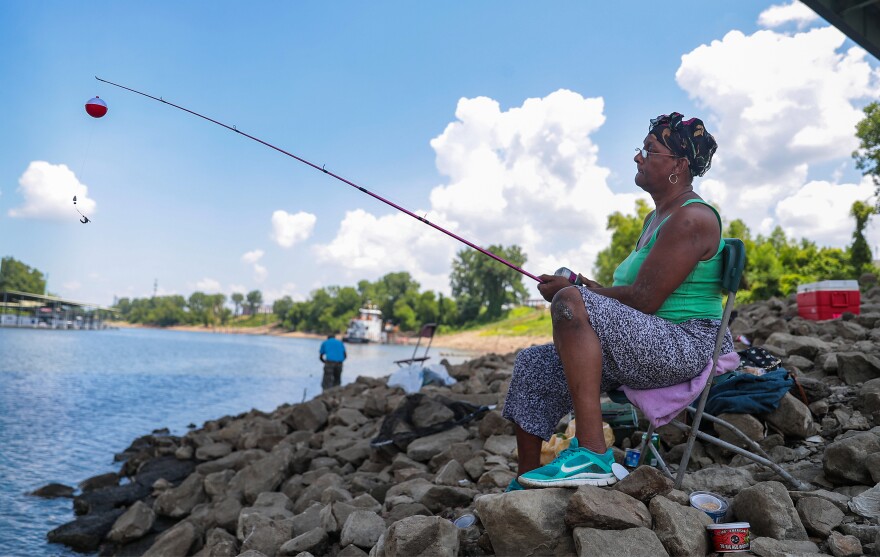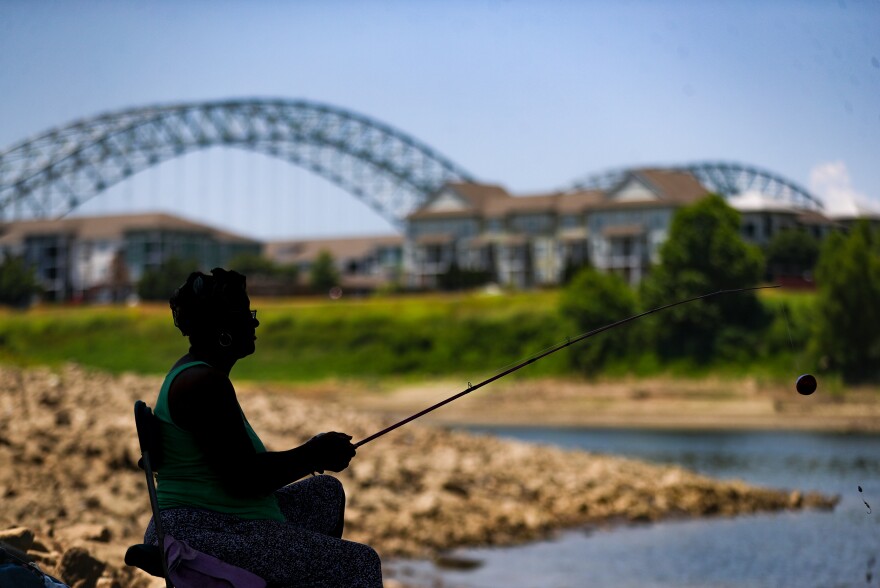Danny Paccasassi, a lifelong Memphis resident, started fishing on the Mississippi River 40 years ago. Now he runs a fishing charter. But he rarely eats the fish he catches.
Fishers on the Tennessee side of the Mississippi River are told: don’t eat the fish. They may contain high levels of methylmercury, chlordane and other organic contaminants. Methylmercury is associated with neurological, reproductive and immunological health, and perinatal exposure can hinder children’s cognitive and psychomotor performance.
But just across the river on the Arkansas side of the river, which is the state border, fishers will find no such warnings, even though it’s the same water and, presumably, holds the same fish.
A “do not consume” advisory means consumption would threaten the general population, not just sensitive groups like children, pregnant women and those who eat a lot of fish – like low-income subsistence fishers who rely on their catches for meals.
“They’re not fishing for fun,” Paccasassi said. “They’re going to probably keep everything they catch.”

There are tips for those who decide to eat the fish anyway: throw back the big ones, avoid fatty fish, wash them before skinning and fileting, broil or grill the fish and throw away the fat if the pollutant is an organic contaminant.
But even for the occasional fisher, Tennessee always advises against eating mercury-contaminated fish.
Fish consumption advisories are issued at the state level, so different agencies can offer conflicting advice along the Mississippi River, which forms a border between many states in the watershed. The Food and Drug Administration regulates commercially sold fish, but it does not claim jurisdiction over sport-caught fish.
The lack of clarity makes it difficult to make informed health decisions along the shared body of water, experts say — particularly for people who catch and eat fish in multiple states.
Lack of clarity for at-risk fishers
Fisherman Paccasassi said most of the fishers see the warning signs posted in Memphis, but they “aren’t going to go online and check for the advisories,” which provide more detailed information about the potential health impacts.
Most states collect and analyze fish tissues for contaminants to determine whether they are safe to eat.
That helps them determine how much and how often certain fish species should be consumed. The water body also may be listed as impaired under the Clean Water Act.
But states test for all different contaminants — and issue very different warnings as a result. Their sampling schedules vary, as do the locations from which samples are collected. And each lab is different, so some states might detect chemicals at higher levels than others. Some fish consumption advisory differences also stem from budgetary constraints, which affect how often fish are sampled and the types of chemicals states test for.
The Upper Mississippi River Basin Association (UMBRA,) established by the governors of Illinois, Iowa, Minnesota, Missouri and Wisconsin to promote cooperation and collaborative policy development, convened a Water Quality Task Force in 2004 to investigate why.
Policy and programs director Lauren Salvato said the patchwork system is a problem: “It's going to be confusing to someone that relies upon or needs that fish, whether they should actually be able to use it or not, and whether they could give it to their kid or their elderly relative.”

The UMRBA report concluded that states need to develop a common testing regime when listing waters as impaired and issuing fish consumption advisories.
The association developed a monitoring plan several years ago and has conducted two fish-monitoring pilot studies on the river — the first between Wisconsin and Minnesota and the other between Illinois, Iowa and Missouri. The goal is to “scale up” the pilot projects, Salvato said, but a permanent funding source is lacking.
It’s not the first effort to create more uniform standards. A similar alliance exists in the Great Lakes Consortium for Fish Consumption Advisories. Its mission is to develop and disseminate consistent advice for shared waters.
Fewer warnings in the Lower Mississippi
No such coordination exists among the lower Mississippi River states, where advisories tend to be less detailed and often starkly contrast with neighboring states.
While Tennessee warns anglers not to consume fish on a stretch of the river, the Arkansas Game and Fish Commission — one of a few agencies that coordinates to determine Arkansas’s advisories — places the river lower on its priority list.
The commission said that “although (the river) is a large fishery resource, our perception is that it is not highly utilized in our state.” They collect angler-use data on bodies of water in Arkansas, but not the Mississippi River, so their evaluations are anecdotal.
Kentucky advises anglers to eat no more than one meal per month of predatory fish and no more than one meal per week of panfish and bottom feeding fish. Women of childbearing age and children get stricter requirements, but the Mississippi River advisory is part of a blanket advisory for all Kentucky waters.
Louisiana and Mississippi have no advisories for the Mississippi River.
Iowa advises sensitive populations — pregnant and nursing women, those planning to become pregnant and children — to limit their consumption to one fish caught in Iowa per week for all large predator species, such as walleye and bass, due to mercury contamination. No limits exist for men.
But on its nearly 87-mile Wisconsin border, Iowa has issued no site-specific fish consumption advisories for the Mississippi River, a point of contrast to the Badger State. The Wisconsin Department of Natural Resources (WDNR) has done so for each of the pools that span the area between successive locks and dams.

While some states might experience a dearth of fish consumption advisories, Wisconsin’s are more extensive – and complicated. In Mississippi River Pool 9, which spans the length from Genoa, Wis., downstream to Harpers Ferry, Iowa, the WDNR issued fish consumption advisories for mercury and PCB.
Women of childbearing age and children under age 15 may safely eat one meal per week of bluegill, bullheads, crappies, inland trout, sunfish and yellow perch and one meal per month of buffalos, carp, catfish, pike, walleye, white bass and all other species and sizes. But they should not eat muskies.
Meanwhile, men and women 50 and older can safely eat unlimited amounts of bluegill, bullheads, crappies, inland trout, sunfish and yellow perch; one meal per week of catfish, pike, walleye and all other species and sizes; and one meal per month of buffalos, carp, muskies and white bass.
And those advisories do not include statewide guidance for all inland waters which breaks down along lines of gender, age and pregnancy status for 11 other common catch-and-consume fish species.
While Iowa also monitors for PCBs and has issued a site-specific advisory for the general population at Pool 15 along its Illinois border, the state does not routinely monitor for PFAS, as Wisconsin does.
Meanwhile, Iowa is revising its guidelines for sensitive populations based on prevalent mercury contamination. Within the next two years, it will issue consumption advisories for lakes and rivers for all fish species, based on their length. Investigating emerging contaminants like PFAS could be on the horizon.
“There is room for improvement,” said Ken Krier, who oversees biological and fish tissue monitoring for the Iowa Department of Natural Resources. “I think that statewide consumption advisory guidance for mercury is the first step in the right direction.”
A decades-long patchwork approach
States have been monitoring for chemicals of concern in fish for decades, some even began before the creation of the EPA in 1970, according to an agency spokesperson. As such, they developed their own approaches, reflecting differences in fish consumption rates.
“A state-by-state approach is capable of tailoring advisories to their constituents,” the spokesperson said. “However, this can result in different advisories when multiple states border the same waterbody.”
The nonprofit advocacy group, American Fisheries Society, documented the problem as early as 1988, in a survey that prompted the EPA to develop non-enforceable guidelines outlining standardized practices for sampling and analyzing fish, risk assessment methods, procedures for making risk management decisions and approaches for communicating risk to the general public.
Do the warnings even reach those most at-risk?
As to whether fishermen understand and follow the advisories, Sean Strom, environmental toxicologist with the Wisconsin Department of Natural Resources, senses variation, a phenomenon that stretches across state borders.
“We have all of our advisories online and in print,” he said. “So, the individual anglers take that into account, whether or not they're fishing on the ‘Wisconsin’ side of the river, or the ‘Iowa’ side of the river.”

Kathryn Crawford, an environmental health scientist, is part of a team of researchers that in 2021 studied the siloed development of recreational fish consumption advisories in the U.S. and found that contradictory advisories impede informed health decisions.
Even as states pour effort into studying fish safety and alerting the public, inconsistencies confuse consumers and undermine the public health goals of fish advisory programs.
Crawford and her team recommended that advisories published for a single waterbody should be consistent in regions where those states are in close proximity, since about 14% of anglers catch and eat fish in multiple states. This kind of consistency is not currently common in the Mississippi River basin.
“It is important that states in regions such as the Lower Mississippi River and the Great Lakes continue to work to identify opportunities for inter-state consistency and collaboration,” the authors wrote.
Lingering confusion about the risks and benefits of consuming fish make public communication campaigns difficult, Crawford said.
The Food and Drug Administration touts bone health and decreased risk in colon and rectal cancers as some of the health benefits associated with eating fish. It also provides general advice for decreased consumption in children and pregnant women.
Crawford said consistent public health messaging is necessary for individuals — particularly those who rely on self-caught fish to meet basic caloric needs — to make informed health decisions.
Should a low-income angler opt for a fish that’s potentially contaminated with mercury or highly-processed cheap foods? Crawford said it’s a complex decision that’s further complicated by inconsistent advisories.
This story is a product of the Mississippi River Basin Ag & Water Desk, an editorially independent reporting network based at the University of Missouri School of Journalism in partnership with Report For America and funded by the Walton Family Foundation.
The Desk wants to hear from you – share questions, tips, feedback or ideas with our newsrooms by emailing info@agwaterdesk.org or texting “MissRiver” to 73224.


